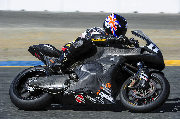In 2009, Taylormade Racing, a small Californian composite firm, decided to build a Grand Prix bike to showcase its carbon-fibre expertise. British-based designer John Keogh, in partnership with Paul Taylor, decided that the recently introduced moto2 class – with its Honda CBR600 engine but completely free chassis rules – would allow full vent to their ideas without having to worry about engine development.
The new design would have a radiator under the seat (rather that in front of the engine); and a wishbone suspension system (instead of telescopic forks). In addition, it would have a full monocoque chassis with carbon-fibre as its material, and a swing-arm of the same composite.
Taylor began building a ‘buck’ (physical model) around the Honda engine in wood and foam that would form the basis of the monocoque chassis and fuel-tank. This tall central tank, desirable to minimize weight shift with diminishing fuel load, clashed with the need to duct air from the high-pressure on the nose back through the headstock, over the mandated airbox and to the under-seat mounted radiator. The solution was the ‘doughnut’ duct – one that went straight through the middle of the fuel cell.
A structured light scanner
While the physical modelling was being undertaken in California, at the drawing board back in the UK Keogh understood that hand-drawings need to be backed up by digital models and drawings. This came in two forms: an initial CAD model build undertaken by Werner Strathaus of Technicon Design and a reverse engineered 3D model developed from scan data. However, the CAD model wasn’t reflecting the bike build on the ground, and Keogh felt it better to use scanning as this would more accurately reflect the reality of the bike.
Mouldings already existed for the chassis, nose and tail, so when the scanning option came up this was seen as an ideal way to accelerate the programme, provide the necessary exact digital model and offer an opportunity to use CFD for aerodynamic testing and verification.
3D Scan Alliance was approached for advice on the best 3D scanning equipment and process, based on the stated requirements, and recommended the use of a scanner from the Solutionix range – specifically, the Solutionix Rexcan CS.
The Rexcan CS is a ‘structured light’ 3D scanner. These are often associated with metrology type applications due to their potentially ultra-high accuracy and resolution. These are, however, extremely fast and due to the use of ‘Blue LED Technology’ it was capable of scanning the dark surface of the body panels.
The scanning process took 1.5hrs in total, with the subsequent mesh processing taking about 30mins. So in a very short space of time Taylormade had a full digital representation of the bodywork that was taking shape in the US and that could be shared between design work in the UK and other contributing parties.
One such party was Dublin, Ohio-based, CFD experts TotalSim USA, which had done some initial work on the CAD model but could now use the more accurate scan-data based model. Certain key aerodynamic qualities were expected and initial CFD studies had shown promising results. But, when it came to the first shakedown of the actual bike a significant overheating problem surfaced. Either the front duct was too big, the radiator too small or the central duct wasn’t working correctly. Using the scanned data with the addition of a scanned but fixed-position rider, the digital version was put through its paces. Ideally this would also include a rider in different positions to obtain comparable data and to investigate how the aerodynamics are working in a number of regimes such as various degrees of lean angle as well as on the straight.
It was obvious immediately that the front duct was compromised on its inner upper surface, losing the flow and thereby starving the rear radiator of cooling air. Enlarging the duct, increasing the radiator core size and altering its angle solved the cooling problem.
Reverse engineering
Taylor commented: “The scanning process was absolutely vital to us, not only in giving correct body data for modelling but in solving the heating problem via CFD. Furthermore, not only is the Solutionix a quick and highly accurate process it is allowing us to correlate any modifications and refine the performance of the bike further. It is an invaluable part of the design process.”
The result is a highly potent race-bike with proven component technologies. Reverse engineering through scanning is now allowing further quantifiable improvements.
